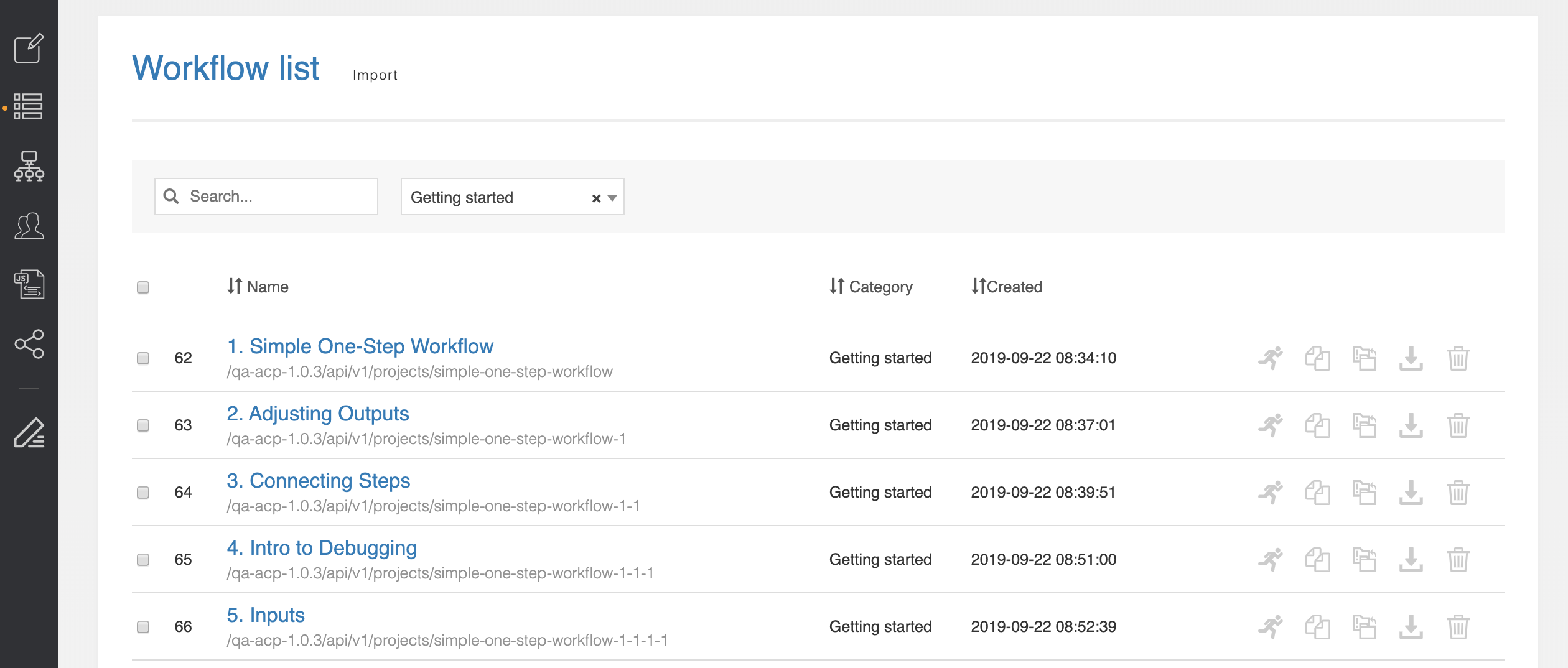Template Workflows
ACP ships with a wide variety of working ACP examples illustrating various concepts and functions.
These examples can be found in the Workflow List and are grouped into distinct categories, like ‘Getting Started’ and ‘ProVision & Amazon.’ To open these workflows, click on the Workflow list, and then filter by the template workflow name, or by category such as "Getting Started".
The ‘Getting Started’ category is of particular importance for new users as it shows specific examples of distinct concepts. This category of workflows will be referenced often in this documentation.
The Examples Library
To open these workflows, click on the Workflow list, and then filter by the template workflow name, or by category such as "Getting Started".
(1) "Simple One-Step Workflow" -- connects to a ProVision instance, gets the TLR, returns it
(2) "Adjusting Outputs" -- does (1), but outputs the TLR id, its Name, and its Parent as separate returns
(3) "Connecting Steps" -- pulls the "Server" resource, then pulls its parent, then outputs the parent's id, name, and parent.
(4) "Intro to Debugging" -- does (3), but looks for the "DOESNOTEXIST" resource. This workflow is designed to fail and show how the Debug section works.
(5) "Inputs" -- does (3), but has the initial resource name as a user-given input
(6) "Branching by HTTP Code" -- The user gives a resource name. If the resource does not exist (HTTP 404), the workflow creates it. If the resource exists, the workflow deletes it.
(7) "Branching by Data Inspection" -- The user gives a resource name. If the resource does not exist (body.name != $name), the workflow creates it. If the resource exists, the workflow deletes it.
(8) "Compound Branching Conditions" -- Same as (6), but if with extra Conditions that error if the entered name is "TLR", "Base", or "Required". These are hard-coded as conditions.
(9) "Working with Arrays" -- pulls a list of all resources of type 'section', returns the name of the 3rd one. This is to show the use of "3.name" syntax.
(10) "Inputs with Routing" -- Same as (6) but the user-given input is used in the conditional statements in the routing section.
(11) "Sub-Steps" -- The workflow pulls a list of all resources of type 'section' then adds the first 3 resources applied to each section. Each resource from Step#1 will contain "child_resources" in the response.
(12) "Iteration Variables" -- The workflow gets the first 3 sections and sets "custom_attr" to be equal to user_given.custom_value.
(13) "Javascript Functions" -- A modification of (1) which gets the TLR and then reverses the characters in the name using Javascript to return "RLT".
(14) "Multiple-Initiator Workflows" -- Outputs multiple workflow results.
(15) "Multiple Connector Workflows" – An example of a workflow with multiple connectors, in this case, ProVision and AWS.
(16) "Connector Credential Segregation" -- Multiple connectors to the same ProVision instance using different credentials to isolate who gets to do what. This is mostly an AWS/Azure/GCloud feature.
(17) "Generic Connectors" – Retrieves a resource name by using custom Generic Connector linking to Provision.
The template workflows may be used for self-guided tutorials, reference for advanced concepts, or cloned and edited for a shortcut to created customized workflows
Additional Information
Continue on to additional User Guide pages for detailed information on working in ACP:
ACP User Guide
